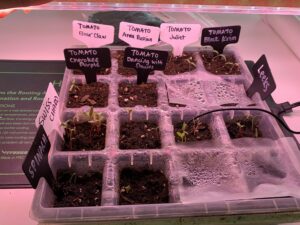Last week was spring break — it was kind of an unplanned whirlwind of activity, and I didn’t get the asparagus bed in or as much done on the website as I hoped. ‘Twas always thus, I suppose. We got in the car to drive to the church building we’ve been moved to Sunday, when someone suggested that we go to Disney World. So we did.
I can see a danger in having such a longer trip to church on Sundays — our family might start thinking. Aloud. Dangerous.
We left church after sacrament, came home, packed, booked a hotel, and left. We were on the road about 2 hours after making the decision. Jared was taking two days off and had a thing in Miami at the end of the week anyway, so it really wasn’t too big a stretch for us. We ended up doing Universal instead of Disney (kids are older, seen it twice anyway), and ended up having a great time. DD and I flew home early while the boys stayed to go to WordCamp. It was a good thing we came home, because Saturday morning the Minute Clinic called to ask me to drive my gg-aunt to the ER. They thought she might have a serious eye infection, but it turned out to be shingles. Poor thing. I hope she recovers quickly.
Anyway, I read up for my lessons, but these were totally easy lessons to prepare. I’m almost embarrassed to share what I did.
Philippians 1-4
I am trying to teach students how to read the scriptures, find out information, and discuss them better. To that end, I assigned each of the four zones a chapter out of Philippians. Zone leaders assigned out verses however they chose to their members. We took 10 minutes to look over our verses, and then each student shared what they learned. This went amazingly well. We only covered the first two chapters in about 20 minutes, so we will pick up tomorrow with chapters 3 and 4.
I added in some commentary and passed around my copy of The New Testament Made Easier Part 2. The kids liked this book. I think the format is a little difficult for reading, but the commentary is mostly pretty good. Definitely helpful for some of the more difficult passages.
We had a discussion about the seemingly awkward phrasing about Jesus’ bowels. I reminded the kids what I taught them in Old Testament: in our day we think with our heads and say we feel with our hearts; in the olden days, they said they thought with their hearts and felt with their stomachs. It’s like “ponder it in your hearts” or “I had a terrible feeling in the pit of my stomach”.
We also covered Paul’s notion that essentially said “any press is good press”. The church took out a full page ad in the playbill of the not-exactly-flattering Book of Mormon play that reads : “You’ve seen the play, now read the book.” The Church’s PR people could have freaked out, but like Paul, they chose to look on the opportunity to talk about the gospel — even when it started out awkwardly — as a blessing.
One of the things I say often — and now the students are starting to do it more, too — is to point out when I marked something. I’ll say “I underlined this” or “I underlined a ton of stuff in this chapter”. I’m trying to model good scripture marking skills by pointing out what I do. Now I’m hearing the kids say “and I underlined….” when they discuss. It seems to have a positive effect on the others, and I see them look down to find what was marked, and often they will mark something a friend marked as well.
Anyway, good discussion. I am really pleased with how the kids are doing at this activity. And incredibly, no one seems to be bored.
Colossians 1-4
I’m doing the same thing as I did in Philippians tomorrow. I put on the board the chapter assignments, and I asked the kids to think about what they might share from their chapter as they read.
General Conference Review
My friend DeAnn, a veteran seminary teacher, always does a General Conference Review after conference, and I’ve tried to do that as well. I wrote a quiz during conference that I used in class as an activity. Attendance at the April conference seems to be lower than October, but regardless, the kids were able to answer most questions. I try to write questions in a way that they can usually find the right answer pretty easily, because I want to establish the truths in their minds — not confuse them. I had three students who missed only two questions.
We did our review on Monday after Conference.
A note on tables
For these lessons I have put the tables up in a square so that nearly everyone can see each other. (That darn post is always in the way.) It seems to be helping the discussion as well. I can’t emphasize enough how much difference it makes in the quality of a classroom discussion when students can see each others’ faces. So many teachers set their classrooms up so that kids only see the backs of each others’ heads. If you’re doing that, try something different and see what happens. Seriously — if your tables are set up the same way every day, ask yourself why. Are your lessons always following the same formula? Shake it up. Are you remembering to use the tables as a tool instead of as a barrier between you and the student?
When the tables are set up this way I have to walk around a bit more. I try to walk around a lot anyway, but I have to loop around lots more when we’re in square formation. It helps with behavior (Teacher Over Shoulder), but it also lets me get where I can see what they’re working on more easily.


